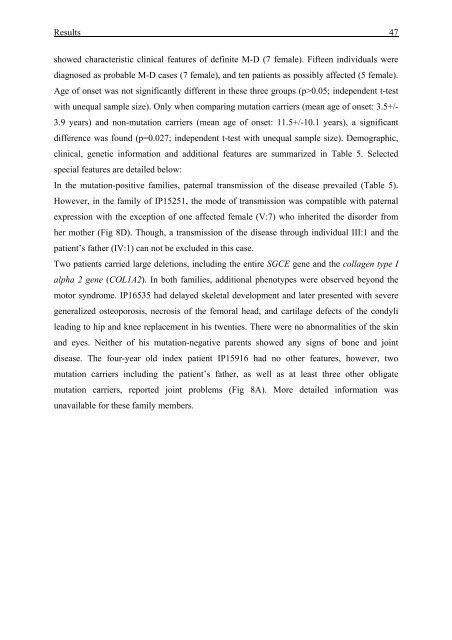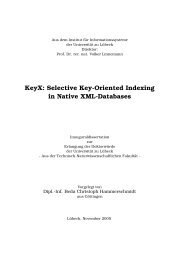Molecular characterisation of SGCE-associated myoclonus-dystonia ...
Molecular characterisation of SGCE-associated myoclonus-dystonia ...
Molecular characterisation of SGCE-associated myoclonus-dystonia ...
You also want an ePaper? Increase the reach of your titles
YUMPU automatically turns print PDFs into web optimized ePapers that Google loves.
Results 47<br />
showed characteristic clinical features <strong>of</strong> definite M-D (7 female). Fifteen individuals were<br />
diagnosed as probable M-D cases (7 female), and ten patients as possibly affected (5 female).<br />
Age <strong>of</strong> onset was not significantly different in these three groups (p>0.05; independent t-test<br />
with unequal sample size). Only when comparing mutation carriers (mean age <strong>of</strong> onset: 3.5+/-<br />
3.9 years) and non-mutation carriers (mean age <strong>of</strong> onset: 11.5+/-10.1 years), a significant<br />
difference was found (p=0.027; independent t-test with unequal sample size). Demographic,<br />
clinical, genetic information and additional features are summarized in Table 5. Selected<br />
special features are detailed below:<br />
In the mutation-positive families, paternal transmission <strong>of</strong> the disease prevailed (Table 5).<br />
However, in the family <strong>of</strong> IP15251, the mode <strong>of</strong> transmission was compatible with paternal<br />
expression with the exception <strong>of</strong> one affected female (V:7) who inherited the disorder from<br />
her mother (Fig 8D). Though, a transmission <strong>of</strong> the disease through individual III:1 and the<br />
patient’s father (IV:1) can not be excluded in this case.<br />
Two patients carried large deletions, including the entire <strong>SGCE</strong> gene and the collagen type I<br />
alpha 2 gene (COL1A2). In both families, additional phenotypes were observed beyond the<br />
motor syndrome. IP16535 had delayed skeletal development and later presented with severe<br />
generalized osteoporosis, necrosis <strong>of</strong> the femoral head, and cartilage defects <strong>of</strong> the condyli<br />
leading to hip and knee replacement in his twenties. There were no abnormalities <strong>of</strong> the skin<br />
and eyes. Neither <strong>of</strong> his mutation-negative parents showed any signs <strong>of</strong> bone and joint<br />
disease. The four-year old index patient IP15916 had no other features, however, two<br />
mutation carriers including the patient’s father, as well as at least three other obligate<br />
mutation carriers, reported joint problems (Fig 8A). More detailed information was<br />
unavailable for these family members.

















